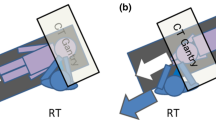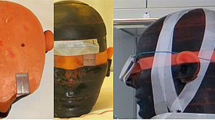Abstract
Objectives
To develop a real-time dose-monitoring system to measure the patient’s eye lens dose during neuro-interventional procedures.
Methods
Radiation dose received at left outer canthus (LOC) and left eyelid (LE) were measured using Metal-Oxide-Semiconductor Field-Effect Transistor dosimeters on 35 patients who underwent diagnostic or cerebral embolization procedures.
Results
The radiation dose received at the LOC region was significantly higher than the dose received by the LE. The maximum eye lens dose of 1492 mGy was measured at LOC region for an AVM case, followed by 907 mGy for an aneurysm case and 665 mGy for a diagnostic angiography procedure. Strong correlations (shown as R2) were observed between kerma-area-product and measured eye doses (LOC: 0.78, LE: 0.68). Lateral and frontal air-kerma showed strong correlations with measured dose at LOC (AKL: 0.93, AKF: 0.78) and a weak correlation with measured dose at LE. A moderate correlation was observed between fluoroscopic time and dose measured at LE and LOC regions.
Conclusions
The MOSkin dose-monitoring system represents a new tool enabling real-time monitoring of eye lens dose during neuro-interventional procedures. This system can provide interventionalists with information needed to adjust the clinical procedure to control the patient’s dose.
Key Points
• Real-time patient dose monitoring helps interventionalists to monitor doses.
• Strong correlation was observed between kerma-area-product and measured eye doses.
• Radiation dose at left outer canthus was higher than at left eyelid.







Similar content being viewed by others
Abbreviations
- AK:
-
Air kerma
- FT:
-
Fluoroscopic time
- IRP:
-
Interventional reference point
- KAP:
-
Kerma-area-product
- LE:
-
Left eyelid
- LOC:
-
Left outer canthus
- MOSFET:
-
Metal-Oxide-Semiconductor Field-Effect Transistor
References
Mooney RB, McKinstry CS, Kamel HA (2000) Absorbed dose and deterministic effects to patients from interventional neuroradiology. Br J Radiol 73:745–751
Wagner LK, McNeese MD, Marx MV, Siegel EL (1999) Severe skin reactions from interventional fluoroscopy: case report and review of the literature. Radiology 213:773–776
Balter S, Hopewell JW, Miller DL, Wagner LK, Zelefsky MJ (2010) Fluoroscopically guided interventional procedures: a review of radiation effects on patients’ skin and hair. Radiology 254:326–341
Spiker A, Zinn Z, Carter WH, Powers R, Kovach R (2012) Fluoroscopy-induced chronic radiation dermatitis. Am J Cardiol 110:1861–1863
Jaco JW, Miller DL (2010) Measuring and monitoring radiation dose during fluoroscopically guided procedures. Tech Vasc Interv Radiol 13:188–193
Balter S, Fletcher DW, Kuan HM et al (2002) Techniques to estimate radiation dose to skin during fluoroscopically guided procedures α. Skin Dose Measurements AAPM 1–10
Stewart FA, Akleyev AV, Hauer-Jensen M et al (2012) ICRP publication 118: ICRP statement on tissue reactions and early and late effects of radiation in normal tissues and organs–threshold doses for tissue reactions in a radiation protection context. Ann ICRP 41:1–322
Worgul BV, Kundiyev YI, Sergiyenko NM et al (2007) Cataracts among Chernobyl clean-up workers: implications regarding permissible eye exposures. Radiat Res 167:233–243
Chodick G, Bekiroglu N, Hauptmann M et al (2008) Risk of cataract after exposure to low doses of ionizing radiation: a 20-year prospective cohort study among US radiologic technologists. Am J Epidemiol 168:620–631
Vano E, Kleiman NJ, Duran A, Rehani MM, Echeverri D, Cabrera M (2010) Radiation cataract risk in interventional cardiology personnel. Radiat Res 174:490–495
Mrena S, Kivela T, Kurttio P, Auvinen A (2011) Lens opacities among physicians occupationally exposed to ionizing radiation–a pilot study in Finland. Scand J Work Environ Health 37:237–243
Theodorakou C, Horrocks JA (2003) A study on radiation doses and irradiated areas in cerebral embolisation. Br J Radiol 76:546–552
Meriçı N, Bor D, Ilgıt E, Öznur İ, Büget N (1998) Comparison of eye lens dose measurement techniques in imaging and interventions of the lachrymal drainage system. Phys Med 14:95–100
Schueler BA, Kallmes DF, Cloft HJ (2005) 3D cerebral angiography: radiation dose comparison with digital subtraction angiography. AJNR Am J Neuroradiol 26:1898–1901
Ilgit ET, Meric N, Bor D, Oznur I, Konus O, Isik S (2000) Lens of the eye: radiation dose in balloon dacryocystoplasty. Radiology 217:54–57
Sandborg M, Rossitti S, Pettersson H (2010) Local skin and eye lens equivalent doses in interventional neuroradiology. Eur Radiol 20:725–733
Moritake T, Matsumaru Y, Takigawa T, Nishizawa K, Matsumura A, Tsuboi K (2008) Dose measurement on both patients and operators during neurointerventional procedures using photoluminescence glass dosimeters. AJNR Am J Neuroradiol 29:1910–1917
Kwan IS, Wilkinson D, Cutajar D et al (2009) The effect of rectal heterogeneity on wall dose in high dose rate brachytherapy. Med Phys 36:224–232
Hardcastle N, Cutajar DL, Metcalfe PE et al (2010) In vivo real-time rectal wall dosimetry for prostate radiotherapy. Phys Med Biol 55:38–59
Qi Z-Y, Deng X-W, Huang S-M et al (2007) Verification of the plan dosimetry for high dose rate brachytherapy using metal–oxide–semiconductor field effect transistor detectors. Med Phys 34:2007–2013
Qi ZY, Deng XW, Huang SM et al (2009) In vivo verification of superficial dose for head and neck treatments using intensity-modulated techniques. Med Phys 36:59–70
Qi Z-Y, Deng X-W, Huang S-M et al (2011) Real-time in vivo dosimetry with MOSFET detectors in serial tomotherapy for head and neck cancer patients. Int J Radiat Oncol Biol Phys 80:1581–1588
Safari MJ, Wong JHD, Ng KH, Jong WL, Cutajar DL, Rosenfeld AB (2015) Characterization of MOSkin detector for in vivo skin dose measurement during interventional radiology procedures. Med Phys 42:2550–2559
Church CA, Kuhn FA, Mikhail J, Vaughan WC, Weiss RL (2008) Patient and surgeon radiation exposure in balloon catheter sinus ostial dilation. Otolaryngol Head Neck Surg 138:187–191
Miller DL, Balter S, Cole PE et al (2003) Radiation doses in interventional radiology procedures: the RAD-IR study: part II: skin dose. J Vasc Interv Radiol 14:977–990
Stecker MS, Balter S, Towbin RB et al (2009) Guidelines for patient radiation dose management. J Vasc Interv Radiol 20:263–273
Vano E, Gonzalez L, Ten JI, Fernandez JM, Guibelalde E, Macaya C (2001) Skin dose and dose-area product values for interventional cardiology procedures. Br J Radiol 74:48–55
Balter S (2006) Methods for measuring fluoroscopic skin dose. Pediatr Radiol 36:136–140
Johnson PB, Borrego D, Balter S, Johnson K, Siragusa D, Bolch WE (2011) Skin dose mapping for fluoroscopically guided interventions. Med Phys 38:5490–5499
Khodadadegan Y, Zhang M, Pavlicek W et al (2011) Automatic monitoring of localized skin dose with fluoroscopic and interventional procedures. J Digit Imaging 24:626–639
Berthelsen B, Cederblad A (1991) Radiation doses to patients and personnel involved in embolization of intracerebral arteriovenous malformations. Acta Radiol 32:492–497
Mustafa AA, Janeczek J (1989) Organ doses from cardiac and carotid digital subtraction angiography. Br J Radiol 62:838–842
Casselden PA (1988) Ocular lens dose in cerebral vascular imaging. Br J Radiol 61:202–204
Acknowledgments
The authors acknowledge and thank the personnel at the following institutions for their technical support in this study: C.C. Lee and M. Mozaker, radiographers at the University of Malaya Medical Centre (UMMC) and K.H. Lam from Philips Healthcare Malaysia. The current research project was approved by the medical ethics committee of the University of Malaya Medical Centre (UMMC), no 1024.22. The scientific guarantor of this publication is Prof. Kwan-Hoong Ng. The authors of this manuscript declare no relationships with any companies whose products or services may be related to the subject matter of the article. This study received funding from a High Impact Research (HIR) grant, UM.C/625/1/HIR/MOHE/MED/38, account no: H-20001-00-E000077 and PPP grant, PG035-2013A from the University of Malaya. No complex statistical methods were necessary for this paper. Institutional Review Board approval was obtained. Written informed consent was waived by the Institutional Review Board. No study subjects or cohorts have been previously reported. Methodology: prospective, experimental, performed at one institution.
Author information
Authors and Affiliations
Corresponding author
Rights and permissions
About this article
Cite this article
Safari, M.J., Wong, J.H.D., Kadir, K.A.A. et al. Real-time eye lens dose monitoring during cerebral angiography procedures. Eur Radiol 26, 79–86 (2016). https://doi.org/10.1007/s00330-015-3818-9
Received:
Revised:
Accepted:
Published:
Issue Date:
DOI: https://doi.org/10.1007/s00330-015-3818-9




